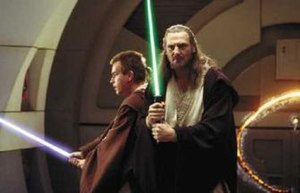Child Development
The psychology of Lego Star Wars II
Babies learn about their own identities through action.
Posted November 21, 2009
Image via Wikipedia
Here's the thing. I've been playing this game for a few months now, and I'm losing track of who I am.
At the beginning of each level, we choose our characters. Today Isaac has gone for Qui-Gon Jinn, while I've plumped for Obi-Wan Kenobi. Both of these characters have lots of hair and long brown capes. I don't know if it's just my old eyes, but I can't tell them apart. Across the distance between the TV and this sofa where we're sitting, I can't see whether I'm controlling the little hooded dude on the left or the one on the right. Maybe I should have picked someone more distinctive, like Yoda or R2D2. But Yoda walks with a limp (although he wields his light saber like a bad ‘un), and R2D2 is only good for getting through doors on spaceships or falling off platforms, which he does with an unnerving, child-like scream.
So I'm there, one of two brown-hooded Jedis, and there is warrioring to be done. The only way to solve the puzzle of my identity is through action. I can use my Nunchuk to move to the left or right, and see which of the characters on the screen moves in response. I can spring into a Jedi Slam, or wave my light saber from side to side, and see what difference my action makes to the image depicted on the screen. By acting, and watching closely the effects of my action, I can work out who I am.
This is a version of a problem that newborn babies have to face. You don't come into the world brimming with self-knowledge; you have to carve out a self for yourself in all sorts of complicated ways. One aspect of this is learning about your self's efficacy: what it can do and not do. Although they probably have certain kinds of innate knowledge that help them with the task, babies have to learn about the effects of their own actions, and thus the limits of the self. Here's how I have described it in the case of Isaac's big sister:
At eight weeks, Athena spent much of her time on her back on her activity mat, looking up at the soft animals that dangled above her. [...] These were the air guitar days. I would play Tom Waits songs on my old electro-acoustic, and she would play along, windmilling her right arm across her left in great wide circles, unicycling her feet as if trying to push herself higher for a better view. [...] Even when I wasn't playing, her arms and legs were constantly in motion. With all this zoology dangling above her, it was only a matter of time before an animal was sent flying. Colourful life-forms would be swinging, inches from her face. Until now she had paid no attention: all this was just part of Athena, absorbed into the universe of her undifferentiated self. But one day, after landing a punch that set Zoë the Zebra pogo-ing, she stopped and looked at what she had done. [...] She had swung that fist, and now a thing was moving that hadn't been moving before. She had made this difference. She had had some impact on the world.
(Charles Fernyhough, [amazon 1583333479], pp. 64-65)
In working out which of these Jedi warriors is ‘me', I have to do a version of what Athena had to do as an eight-week-old. I have to use trial and error in working out who I am. As we'll see next time, I am going to face further complexities in sorting out my identity crisis. Truly aligning myself with Obi-Wan Kenobi, as opposed to all the other characters that fill the screen, is going to take some further action and observation.



